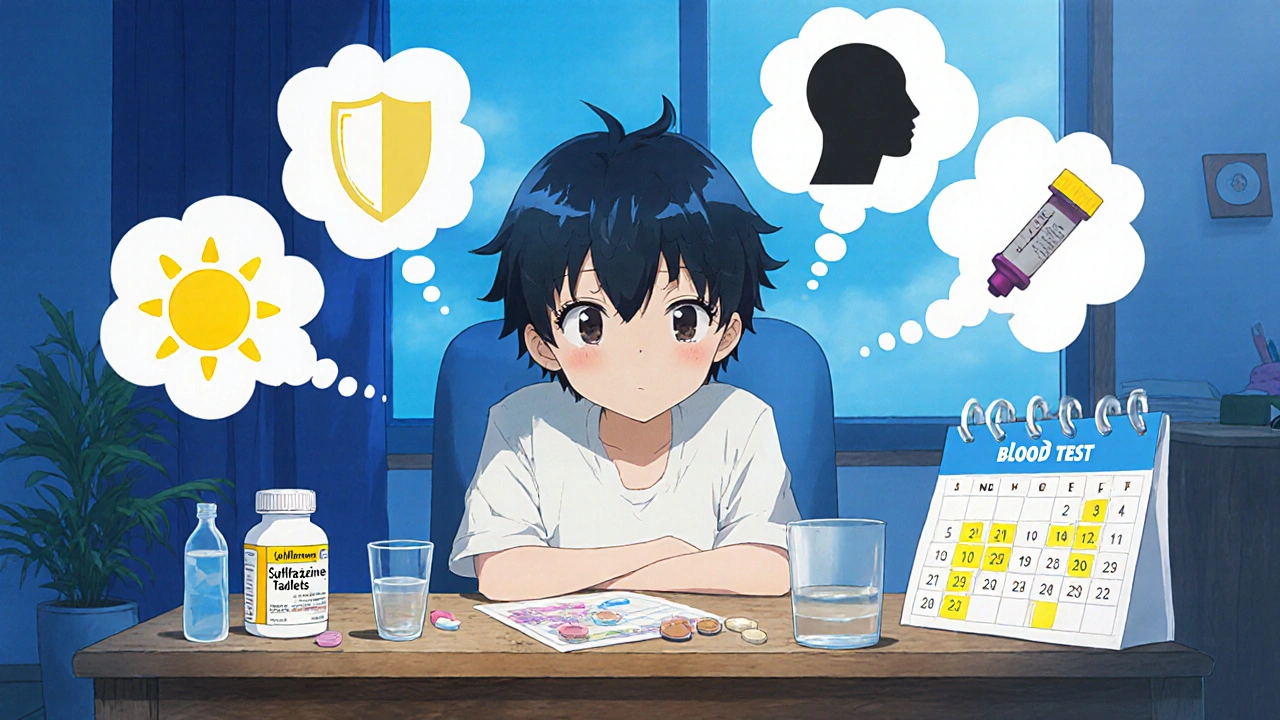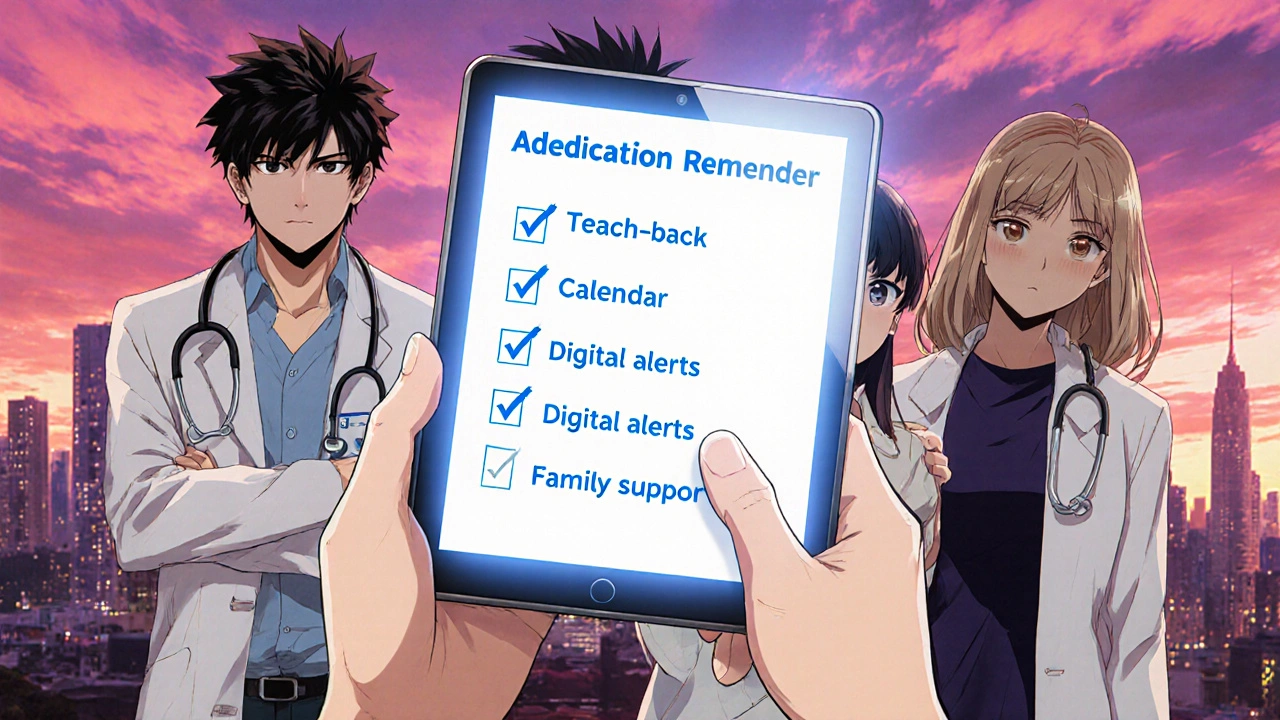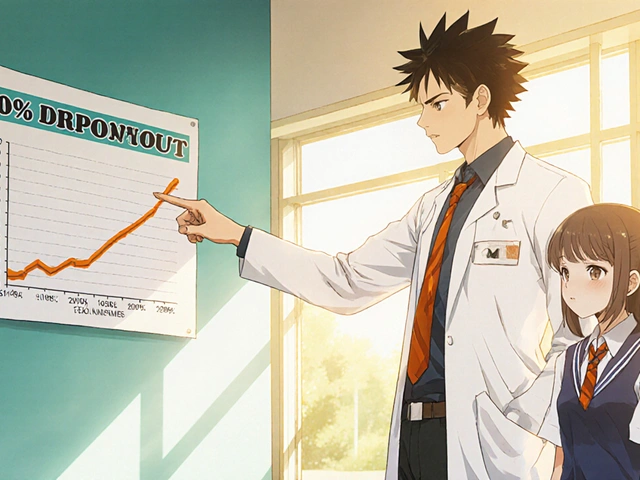Sulfasalazine Adherence Calculator
Up to 40% of patients stop sulfasalazine within the first 3 months. This calculator estimates your risk of early discontinuation based on your education level and adherence habits.
Did you know that up to 40% of patients stop sulfasalazine within the first three months because they weren’t prepared for the medication’s quirks? That dropout rate isn’t just a statistic - it translates into flare‑ups, hospital visits, and higher healthcare costs. The missing piece? Clear, practical patient education.
What Is Sulfasalazine and Why Is It Used?
Sulfasalazine is a combination drug that splits in the colon into two active metabolites: sulfapyridine and 5‑aminosalicylic acid (5‑ASA). The sulfa component helps control immune activity, while the 5‑ASA part reduces intestinal inflammation. Because of this dual action, sulfasalazine is a mainstay for ulcerative colitis, certain cases of Crohn’s disease, and rheumatoid arthritis. Its versatility makes it a go‑to option, but the same complexity also demands thorough patient counseling.
Why Patient Education Impacts Outcomes
When patients understand how a drug works, they’re more likely to stick to the regimen, report side effects early, and follow monitoring schedules. Studies from gastroenterology clinics in 2023 showed that patients who received a structured education session had a 25% higher adherence rate compared with those who only got a prescription sheet. In practical terms, that means fewer disease flares and less need for rescue steroids.
Common Indications and What Patients Should Expect
For Sulfasalazine therapy, the most frequent indications are:
- Moderate to severe ulcerative colitis
- Active rheumatoid arthritis not controlled by NSAIDs alone
- Some forms of Crohn’s disease involving the colon
Patients should know that onset of symptom relief can take 2‑4 weeks for arthritis and up to 8 weeks for colitis. Setting realistic expectations prevents premature discontinuation.
Side Effects: What to Tell Your Patients
Side effects are the most common reason for stopping the drug. A short education guide covering the following points can make a huge difference:
- Gastro‑intestinal upset - nausea, abdominal cramps, and loss of appetite are typical early on. Advise taking the medication with food and staying hydrated.
- Headache and dizziness - usually mild, but patients should avoid driving if they feel impaired until they know how they react.
- Photosensitivity - sulfa drugs can make skin more prone to sunburn. Recommend sunscreen (SPF30+) and protective clothing.
- Blood‑related changes - rare but serious drops in white blood cells or platelets. Explain the need for periodic blood tests.
Because folate deficiency can develop with long‑term use, many clinicians prescribe a daily folic acid supplement. Emphasize that supplementation helps prevent anemia and may reduce the risk of birth defects in women of child‑bearing age.

Dosage, Administration, and Common Pitfalls
Typical starting doses are 500mg twice daily for ulcerative colitis and 1g twice daily for rheumatoid arthritis, with the possibility of titrating up to 3g per day. Key counseling points:
- Take the tablets whole with a full glass of water; crushing can release the sulfa component too early and increase nausea.
- If a dose is missed, take it as soon as remembered unless it’s less than 12hours away from the next dose - don’t double up.
- Store at room temperature away from direct sunlight to preserve stability.
Patients often wonder whether they can split the dose (e.g., take one tablet in the morning and one at night). Splitting is acceptable only if the prescription specifies a divided dose; otherwise, keep the full tablet intact.
Monitoring: Labs and Follow‑up
Regular monitoring is a cornerstone of safe sulfasalazine use. A typical schedule might look like:
| Time Point | Test | Purpose |
|---|---|---|
| Baseline | CBC, LFTs, renal function, folate level | Identify pre‑existing issues, set reference values |
| 2 weeks | CBC | Detect early bone‑marrow suppression |
| 1 month | Liver enzymes, renal function | Watch for hepatotoxicity or nephrotoxicity |
| Every 3 months | CBC, LFTs, renal function | Long‑term safety surveillance |
Explain why each test matters; patients are more likely to keep appointments when they know the “why.”
Medication Interactions and What to Flag
Because sulfasalazine is a sulfonamide, it can interact with several drug classes:
- Warfarin - may increase bleeding risk; monitor INR closely.
- Azathioprine or 6‑mercaptopurine - additive bone‑marrow suppression; check CBC more frequently.
- Methotrexate - overlapping hepatotoxicity; consider liver function monitoring every 4-6 weeks.
- Trimethoprim‑sulfamethoxazole - heightened sulfa toxicity; avoid unless absolutely necessary.
Encourage patients to keep an up‑to‑date medication list and share it with every new prescriber.

Boosting Adherence Through Tailored Education
Adherence isn’t just a matter of willpower; it’s a behavior shaped by knowledge, routine, and support. Effective strategies include:
- Teach‑back method - ask patients to repeat dosing instructions in their own words. \n
- Medication calendars - visual tools that mark dose days, blood‑test appointments, and side‑effect checkpoints.
- Digital reminders - smartphone apps or SMS alerts synchronized with the dosing schedule.
- Family involvement - involve a caregiver in the counseling session to create a support network.
When patients feel their concerns are heard and their regimen fits into daily life, they stay on therapy longer.
Practical Steps for Healthcare Providers
To embed education into routine care, clinicians can follow a simple checklist:
- Provide a written handout that outlines indication, dose, side‑effects, and monitoring plan.
- Schedule a brief 10‑minute education session at the first prescription fill.
- Use the teach‑back technique to confirm understanding.
- Set up a follow‑up call or portal message within two weeks to address early side‑effects.
- Document counseling in the EMR using a standardized template.
Adopting this workflow costs a few minutes per patient but can cut downstream hospitalizations by 15‑20%.
Key Takeaways
- Clear education reduces early discontinuation of sulfasalazine.
- Patients need concrete guidance on side‑effects, dosing, and lab monitoring.
- Including caregivers and digital tools improves long‑term adherence.
- Regular monitoring and proactive communication catch problems before they spiral.
Frequently Asked Questions
Can I take sulfasalazine if I’m pregnant?
Sulfasalazine is classified as pregnancy category B. It is generally considered safe, but doctors usually add folic acid supplementation and monitor the pregnancy closely. Always discuss risks with your OB‑GYN before starting.
What should I do if I develop a rash?
Stop the medication and contact your provider immediately. A rash can signal a hypersensitivity reaction that may require steroids or an alternative drug.
How often do I need blood tests?
Initial labs are done before starting therapy, then a CBC at two weeks, liver and kidney panels at one month, and then every three months if results are stable.
Can I combine sulfasalazine with other arthritis meds?
Yes, it’s often used together with methotrexate or biologics. However, your doctor will watch for overlapping liver toxicity or bone‑marrow suppression.
Is there a generic version?
The drug is widely available in generic form, which can lower out‑of‑pocket costs. Check with your pharmacy or insurance for the best pricing.





kendra mukhia
October 17 2025I cannot stress enough how a single well‑crafted education session can turn a potential dropout into a lifelong champion of sulfasalazine therapy. The data isn’t just numbers; it’s a narrative of patients wrestling with side‑effects, dosing puzzles, and the ever‑looming fear of the unknown. When clinicians skip the teach‑back method, they essentially hand the patient a broken map and expect them to navigate a treacherous terrain. From my experience in both gastroenterology and rheumatology clinics, the most common misunderstanding is that the drug works instantly, which is a myth that fuels premature cessation. So, let’s rewrite the script: start with a clear explanation of the dual mechanism, follow with practical tips on meals, and end with a scheduled lab calendar. Only then will we see that coveted dip in hospital admissions and a soaring adherence curve.
Bethany Torkelson
October 17 2025Stop treating patient education like an afterthought-it's the lifeline these folks desperately need!
Grace Hada
October 17 2025Knowledge is the scaffolding upon which adherence is built, not a luxury add‑on. If we deprive patients of that scaffolding, we condemn them to collapse under the weight of their disease. Hence, every clinician must make education a non‑negotiable pillar.
alex montana
October 17 2025Exactly! you got it-patients need the *why* and the *how*!! but seriously, if we don't spell it out clearly they just guess??.
Sarah Hanson
October 17 2025I wholeheartedly agree that a structured handout can serve as an invaluable reference for patients. Including clear dosage instructions, potential side‑effects, and a timeline for lab tests empowers individuals to take charge of their health. It's also important to ensure that the language is accessible, so avoid overly technical jargon whenever possible. That said, a brief missspell like "releif" can actually make the document feel more human and less intimidating.
Nhasala Joshi
October 17 2025But what the pharma giants don’t want you to see is that they *intentionally* under‑fund patient education to keep profits soaring 😱. They feed us glossy brochures while hiding the gritty reality of sulfa‑induced photosensitivity and hidden blood dyscrasias. The hidden agenda is obvious: create a dependency on follow‑up visits that line their pockets. Only a well‑informed patient can break this cycle and demand transparent, evidence‑based counseling. Stay vigilant, question every pamphlet, and trust the data, not the marketing hype 🕵️♀️.
Wyatt Schwindt
October 17 2025Providing clear instructions really does reduce early drop‑out. Patients appreciate knowing exactly what to expect.
Lyle Mills
October 17 2025The adherence curve correlates strongly with patient‑centered education modules. Integrating pharmacokinetic rationale can further boost confidence.
Barbara Grzegorzewska
October 17 2025Allow me to elucidate why the mere mention of "patient education" in a superficial handout is tantamount to offering a gourmet meal on a paper plate. First, the average American patient is inundated with a deluge of misinformation, a fact that the mainstream media conveniently glosses over while patting themselves on the back for statistical victories. Second, the pharmacodynamics of sulfasalazine demand an intellectual rigor that most physicians seem unwilling to bestow upon their clientele, opting instead for cursory bullet points that read like a toddler’s grocery list. Third, the notion that a generic brochure can substitute for a personalized, culturally attuned conversation betrays a flagrant disrespect for the very individuals we purport to serve. Moreover, the U.S. healthcare system, with its labyrinthine insurance labyrinths, often incentivizes volume over value, thereby relegating education to a perfunctory checkbox. When we strip away the veneer of bureaucratic efficiency, we uncover a stark reality: the patient’s adherence hinges on the depth and clarity of the counsel they receive. Take, for instance, the common misconception that sulfasalazine attacks the gut like a barbaric invader; in truth, its bifurcated mechanism operates with surgical precision, modulating immune pathways while soothing mucosal inflammation. If this nuanced narrative is not communicated with eloquence and passion, the patient will likely abandon the regimen in favor of the seductive allure of over‑the‑counter analgesics. Furthermore, the specter of side‑effects-photosensitivity, hematologic anomalies, and gastrointestinal turmoil-cannot be mentioned in passing; each warrants a meticulous exposition, complete with mitigation strategies. Neglecting to advise a simple folic acid supplement, for example, is a dereliction of duty that could precipitate macrocytic anemia and compromise reproductive health. One must also consider the sociocultural tapestry: patients from diverse backgrounds may harbor distinct beliefs about medication, necessitating a tailored educational approach that transcends one‑size‑fits‑all rhetoric. In the crucible of clinical practice, the physician’s role evolves from a prescriber to an educator, a mentor, and-dare I say-a guardian of therapeutic fidelity. Thus, embedding a systematic education protocol into every sulfasalazine initiation is not merely advisable; it is an ethical imperative. Our competitors across the Atlantic may scoff at such procedural rigidity, but we, the custodians of American medical excellence, must lead by example. Let us eschew complacency, champion comprehensive counseling, and watch the adherence rates skyrocket like rockets over the Fourth of July. In summary, patient education is the keystone that transforms pharmacologic potential into clinical triumph, and any attempt to diminish its importance is nothing short of intellectual heresy.
Nis Hansen
October 17 2025Your eloquent treatise reminds us that education is the catalyst that converts therapeutic intent into measurable outcomes. When patients internalize the mechanistic story of sulfasalazine, they become active participants rather than passive recipients. Let’s harness this momentum to build structured curricula that are both scientifically rigorous and emotionally resonant. Together we can elevate adherence metrics and set a new benchmark for patient‑centered care.
Fabian Märkl
October 17 2025Hey folks, just wanted to drop a quick reminder that a friendly chat about meds can work wonders! A smile, a simple handout, and maybe a quick demo of how to take the pill with food can cut down those nasty side‑effects. And don't forget to set a reminder on your phone – those little nudges are game‑changers 😊. Stay healthy and keep the conversation going!
Avril Harrison
October 17 2025Totally agree, the vibe of a relaxed explanation often sticks better than a lecture. I’ve seen mates actually follow the schedule just because the doc made it sound easy. Cheers for the tip!
Natala Storczyk
October 17 2025THIS IS WHY AMERICAN DOCTORS MUST TAKE CHARGE OF PATIENT EDUCATION-NO FOREIGN RESEARCH CAN COMPETE WITH OUR INNOVATION! WE ARE THE BASTION OF MEDICAL EXCELLENCE, YET WE STILL LET PATIENTS SLIP THROUGH THE CRACKS OF NEGLIGENCE!!! THEY SAY 'IT\'S JUST A HANDOUT'-BUT WE KNOW IT\'S A BATTLEFIELD OF COMPLIANCE! IF WE DON\'T INSIST ON RIGOROUS COUNSELING, WE\'RE ONLY SERVING TO BOOST OTHER COUNTRIES' STATISTICS!! LET\'S RECLAIM OUR STANDARDS AND MAKE EVERY SULFASALAZINE PATIENT A HERO OF THE HOMEFRONT!
nitish sharma
October 17 2025I share your patriotic zeal, but let us channel it into constructive, evidence‑based education initiatives. By establishing formal workshops and clear protocols, we can ensure that every patient receives the comprehensive guidance they deserve. Such endeavors not only uphold our national reputation but also embody the compassionate ethos of medicine. Together, we can foster adherence and protect the health of our fellow citizens.